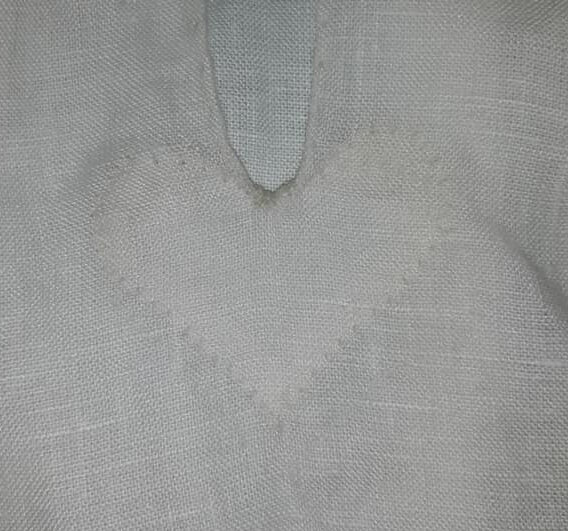Stitches
Top Stitching
The left side of the image shows the fine top stitching on a Gentleman’s shirt. One stitch over every two threads.
The right side of the image shows the medium length top stitching on a Middling Sort shirt. One stitch over every three threads.
*Stitches worked in darker thread for demonstration purposes.
Whipped Gathers
Whipped gathers are used to gather fine fabrics with rolled edges such as these breast ruffles.
Stroked Gathers
Stroked gathers are made with parallel rows of running stitches which are pulled together to shrink a wide fabric into a smaller area. These can be found on the shoulders, wrists, and necks of shirts.
Laundry Marks
Laundry marks can be found near the right side slit gusset of many shirts (and sometimes below the bosom slit), as well as the back side of the latchet tab of neck stocks. These are the owner’s initials and the item’s inventory number and are cross stitched in blue or red silk, or in blue linen thread.
Optional Touches
Breast Ruffles
Sleeve Ruffles
British Identification Markings
“To prevent …the least embezzlement of the necessaries, with which a Soldier is provided, and to give a greater chance for the discovery of thefts, all their linen articles should have the name of the owner, with the number of the Regiment and Company he belongs to, marked with a mixture of vermilion and nut-oil… under the slit of the bosom of the shirt… as at the weekly inspection of necessaries, an Officer can easily examine, if the shirts at that time worn by the Soldiers are their own…”
-Cuthbertson's System for the Complete Interior Management and Oeconomy of a Battalion of Infantry
Heart Bits
Small piece of shirting are sometimes affixed to the base of the bosom slit, sometimes square with a slash, but commonly heart shaped. Regardless of shape, these are called heart bits and are a method of reinforcing the end of the slit.
Fagoting
This interlinking embroidery stitch is sometimes seen as a decorative reinforcement at the bottom of the bosom slit.
Thread Buttons
Buttons on shirts were typically made from thread as these would survive the harsh laundering process undergone by linen garments.
These simple thread buttons are made from a wrapped core of densely looped thread with a blanket stitch to bind them together. These will render a rather stiff and sturdy button.
Dorset Cartwheel Buttons
Named for Dorset, England from whence they originated, these buttons began commercial production in 1622 and remained highly popular until around 1850 when machine made buttons flooded the market.
These buttons are made around a metal ring. A blanket stitch is worked around the ring and then the spokes are wrapped across the diameter. There is a back stitched worked over these spokes in the round.
18th c. Linen Neck Stock
Pleats
These Stocks are constructed with a heavily pleated section of handkerchief weight linen. These pleats are stitched down to a backing piece so that even after laundering, a simple pressing would render the stock wearable without a painstaking re-pleating process.
Buckle Tab
Stocks of the 18th century were typically closed using a buckle with three studs which were set into buttonholes on a short tab at one end of the stock. This way, the buckle could be easily removed so that the stock might be laundered.
There is a fine row of top stitching at each end of this tab.
Latchet tab
The other end of the stock features a longer, tapered tab which fits through the buckle.
There is a fine row of top stitching a the inside end of this tab.
Make it stand out.
Pleats
These Stocks are constructed with a heavily pleated section of silk. These pleats are stitched down to a backing piece so that even after laundering, a simple pressing would render the stock wearable without a painstaking re-pleating process.
Buckle Tab
Stocks of the 18th century were typically closed using a buckle with three studs which were set into buttonholes on a short tab at one end of the stock. This way, the buckle could be easily removed so that the stock might be laundered.
There is a fine row of top stitching at each end of this tab.
Latchet tab
The other end of the stock features a longer, tapered tab which fits through the buckle.
There is a fine row of top stitching a the inside end of this tab.

















